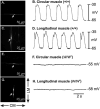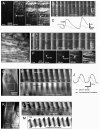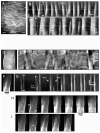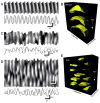ICC-MY coordinate smooth muscle electrical and mechanical activity in the murine small intestine
- PMID: 20059699
- PMCID: PMC2856807
- DOI: 10.1111/j.1365-2982.2009.01448.x
ICC-MY coordinate smooth muscle electrical and mechanical activity in the murine small intestine
Abstract
Background: Animals carrying genetic mutations have provided powerful insights into the role of interstitial cells of Cajal (ICC) in motility. One classic model is the W/W(V) mouse which carries loss-of-function mutations in c-kit alleles, but retains minimal function of the tyrosine kinase. Previous studies have documented loss of slow waves and aberrant motility in the small intestine of W/W(V) mice where myenteric ICC (ICC-MY) are significantly depleted.
Methods: Here, we used morphological and electrophysiological techniques to further assess the loss of ICC around the circumference of the small intestine and determine consequences of losing ICC-MY on electrical activity, Ca(2+) transients and contractions of the longitudinal muscle (LM).
Key results: In wild-type mice, there was coherent propagation of Ca(2+) transients through the ICC-MY network and spread of this activity to the LM. In short segments of small intestine in vitro and in exteriorized segments, slow waves coordinated smoothly propagating Ca(2+) waves and contractions in the LM of wild-type mice. In W/W(V) mice, Ca(2+) waves were initiated at variable sites along and around intestinal segments and propagated without constraint unless they collided with other Ca(2+) waves. This activity resulted in abrupt, uncoordinated contractions.
Conclusions & inferences: These results show how dominance of pacemaking by ICC-MY coordinates propagating con-tractions and regulates the spontaneous activity of smooth muscle.
Conflict of interest statement
Competing Interests: the authors have no competing interests.
Figures







Similar articles
-
A myogenic motor pattern in mice lacking myenteric interstitial cells of Cajal explained by a second coupled oscillator network.Am J Physiol Gastrointest Liver Physiol. 2020 Feb 1;318(2):G225-G243. doi: 10.1152/ajpgi.00311.2019. Epub 2019 Dec 9. Am J Physiol Gastrointest Liver Physiol. 2020. PMID: 31813235 Free PMC article.
-
Conditional genetic deletion of Ano1 in interstitial cells of Cajal impairs Ca2+ transients and slow waves in adult mouse small intestine.Am J Physiol Gastrointest Liver Physiol. 2017 Mar 1;312(3):G228-G245. doi: 10.1152/ajpgi.00363.2016. Epub 2016 Dec 15. Am J Physiol Gastrointest Liver Physiol. 2017. PMID: 27979828 Free PMC article.
-
Heterogeneities in ICC Ca2+ activity within canine large intestine.Gastroenterology. 2009 Jun;136(7):2226-36. doi: 10.1053/j.gastro.2009.02.060. Epub 2009 Mar 5. Gastroenterology. 2009. PMID: 19268670 Free PMC article.
-
Generation and propagation of gastric slow waves.Clin Exp Pharmacol Physiol. 2010 Apr;37(4):516-24. doi: 10.1111/j.1440-1681.2009.05331.x. Epub 2009 Nov 23. Clin Exp Pharmacol Physiol. 2010. PMID: 19930430 Review.
-
[Roles of interstitial cells of Cajal in regulation of motility of the mouse intestine].Nihon Yakurigaku Zasshi. 2004 Mar;123(3):170-8. doi: 10.1254/fpj.123.170. Nihon Yakurigaku Zasshi. 2004. PMID: 14993729 Review. Japanese.
Cited by
-
Age-associated changes of the intrinsic nervous system in relation with interstitial cells in the pre-weaning goat rumen.Aging (Albany NY). 2019 Jul 14;11(13):4641-4653. doi: 10.18632/aging.102076. Aging (Albany NY). 2019. PMID: 31305258 Free PMC article.
-
A Close Relationship Between Networks of Interstitial Cells of Cajal and Gastrointestinal Transit In Vivo.Front Pharmacol. 2020 Nov 20;11:587453. doi: 10.3389/fphar.2020.587453. eCollection 2020. Front Pharmacol. 2020. PMID: 33633564 Free PMC article.
-
Transplantation of enteric nervous system stem cells rescues nitric oxide synthase deficient mouse colon.Nat Commun. 2017 Jul 3;8:15937. doi: 10.1038/ncomms15937. Nat Commun. 2017. PMID: 28671186 Free PMC article.
-
A high throughput machine-learning driven analysis of Ca2+ spatio-temporal maps.Cell Calcium. 2020 Nov;91:102260. doi: 10.1016/j.ceca.2020.102260. Epub 2020 Jul 28. Cell Calcium. 2020. PMID: 32795721 Free PMC article.
-
Mechanisms of Connexin-Related Lymphedema.Circ Res. 2018 Sep 28;123(8):964-985. doi: 10.1161/CIRCRESAHA.117.312576. Circ Res. 2018. PMID: 30355030 Free PMC article.
References
-
- Vanderwinden JM, Rumessen JJ. Interstitial cells of Cajal in human gut and gastrointestinal disease. Microsc Res Tech. 1999;47:344–360. - PubMed
-
- Sanders KM, Ordög T, Koh SD, Torihashi S, Ward SM. Development and plasticity of interstitial cells of Cajal. Neurogastroenterol Motil. 1999;11:311–38. - PubMed
-
- Burns AJ. Disorders of interstitial cells of Cajal. J Pediatr Gastroenterol Nutr. 2007;45:103–6. - PubMed
-
- Rolle U, Piaseczna-Piotrowska A, Puri P. Interstitial cells of Cajal in the normal gut and in intestinal motility disorders of childhood. Pediatr Surg Int. 2007;23:1139–52. - PubMed
-
- Farrugia G. Interstitial cells of Cajal in health and disease. Neurogastroenterol Motil. 2008;20:54–63. - PubMed
Publication types
MeSH terms
Substances
Grants and funding
LinkOut - more resources
Full Text Sources
Miscellaneous

